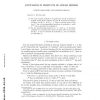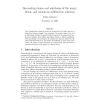80 search results - page 1 / 16 » Antichains in Products of Linear Orders |
ORDER
2002
15 years 10 hour ago
2002
We show that: (1) For many regular cardinals (in particular, for all successors of singular strong limit cardinals, and for all successors of singular -limits), for all n {2, 3, ...
99
Voted
ORDER
2006
15 years 8 days ago
2006
The C-subfunction relations on the set of functions on a finite base set A defined by function classes C are examined. For certain clones C on A, it is determined whether the part...
JCT
2010
14 years 10 months ago
2010
A lattice path matroid is a transversal matroid for which some antichain of intervals in some linear order on the ground set is a presentation. We characterize the minor-closed cla...
JSYML
2006
15 years 9 days ago
2006
Levin and Schnorr (independently) introduced the monotone complexity, Km(), of a binary string . We use monotone complexity to define the relative complexity (or relative randomnes...
106
click to vote
SIAMCOMP
1998
15 years 8 hour ago
1998
A chain of a set P of n points in the plane is a chain of the dominance order on P. A k-chain is a subset C of P that can be covered by k chains. A k-chain C is a maximum k-chain ...


